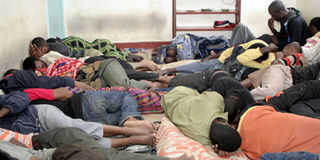Police grapple with influx of poor Ethiopians

Illegal immigrants from Ethiopia crowded inside a single room at a house in Ngong Town on June 23, 2010. Photo/FILE
For quite a long while, Kenya has become a haven for illegal Ethiopian immigrants fleeing their country in search of a better life.
The immigrants are entering Kenyan in droves, presenting a security and logistical nightmare for security agents.
These foreigners access the country through the porous border in Moyale and proceed to northern and upper eastern Kenya.
Tales of Ethiopians being arrested, prosecuted and others repatriated in their hundreds have become legion in Moyale and Isiolo.
The Nation has learnt that the Ethiopians, mostly youths, are fleeing their country for South Africa, where they hope to find jobs.
It is believed those who have successfully used this illegal route and landed in South Africa, are urging their countrymen to try their luck, creating a frenzy among the jobless and poverty-stricken Ethiopians to join the band wagon.
Since Ethiopia is a landlocked country, the immigrants prefer Kenya, its southern neighbour and not Eritrea to the north, Sudan to the west and Djibouti and Somalia to the east, some of which are traditionally hostile.
The “smuggling” of Ethiopians is lucrative and has become a cash cow for “hired” transporters and other brokers who arrange transport, safe houses and other logistics until the immigrants reach their destination.
End the menace
Kenyans involved in this illegality, have, however, not been left out by police in their efforts to end the menace, as they are often charged alongside the immigrants. Smuggling of humans is outlawed locally and internationally.
The UN outlaws any form of human exploitation for financial gain either through forced labour or sexually.
Like human trafficking, people smuggling is listed as a serious crime and differs with the former where people, especially women and children, are sold for sexual or labour exploitation.
The latter involves people voluntarily paying a smugglers to covertly transport them from one location to another.
In this case, mostly young Ethiopians are said to sell family property or personal belongings and pay smugglers to take them to preferred destinations where they hope to land jobs and get financial breakthrough.
Security officials are struggling to seal the loopholes used by the immigrants and have identified areas such as Forore and Turkana along the porous Ethiopia-Kenya border in Moyale District as the most notorious.
The foreigners are said to avoid the lengthy screening process at designated border entry points where the government also puts a cap on the number of Ethiopians allowed into the country at a particular time.
“Traditionally, the country does not require Ethiopians to acquire visas when visiting the country, but most of them enter the country illegally to beat rigorous immigration requirements,” says Upper Eastern deputy provincial commissioner Wenslas Ong’wayo.
To make it to Nairobi, where they travel by road to Tanzania, Mozambique and eventually South Africa, the illegal immigrants and their transporters have devised ways to evade police road blocks.
Evade road blocks
Mr Ong’wayo says despite the fact that there are about five road blocks from Moyale to Isiolo, the Ethiopians still manage to evade them by trekking for several kilometres through the bushes and boarding a vehicle where there are no police barriers.
But despite the transporters’ ingenuity to escape police traps, security officers say they have arrested an estimated 2,000 Ethiopian immigrants since the beginning of the year.




